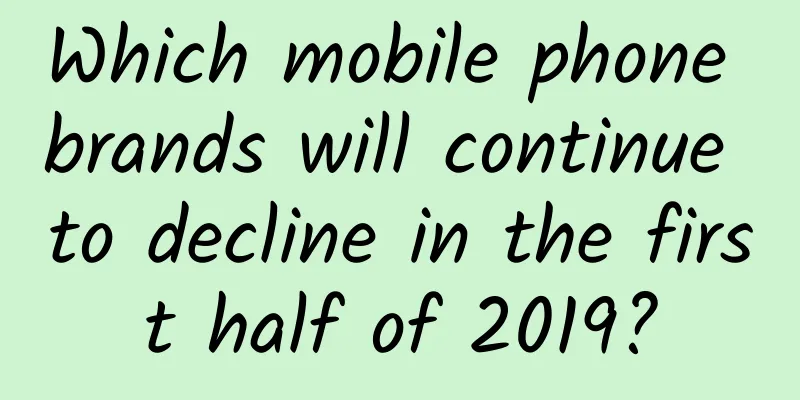Which mobile phone brands will continue to decline in the first half of 2019?

|
"At the beginning of the year, the industry's overall judgment on the smartphone market was that it would continue to be sluggish, but I didn't expect the data just released to be so pessimistic." A mobile phone industry analyst from a research institute told Dongdong Notes that the data released by CAICT today shows that the reshuffle of the domestic mobile phone market will continue to accelerate, and the few second-tier brands currently available may also experience a sharp decline in 2019. "Even the top brands are likely to experience large fluctuations." The decline in February exceeded that of the past two years. On March 12, the China Academy of Information and Communications Technology released the "February 2019 Domestic Mobile Phone Market Operation Analysis Report". Data showed that the total shipments of the domestic mobile phone market in February were 14.511 million units, a year-on-year decrease of 19.9%; smartphone shipments were 13.989 million units, a year-on-year decrease of 20.1%. After carefully reading the relevant data in the report, Dongdong Notes combined the "January Domestic Mobile Phone Market Operation Analysis Report" released by the China Academy of Information and Communications Technology last month, as well as relevant research and analysis data on the domestic mobile phone market in 2018 released by IDC and other institutions, to interpret the market situation faced by domestic mobile phone brands this year. We also hope that the relevant analysis and judgment can be of certain help to the industry and users. Some analysts said that apart from the long Spring Festival holiday and other factors, the decline in domestic mobile phone market shipments in February reflects the wait-and-see attitude of both users and manufacturers. The user factor is mainly due to the decline in the desire to change phones and the "contentment" with the current mobile phone product technology. Before more innovative technologies and applications emerge, the cautious wait-and-see attitude will continue for a long time, and the negativity caused by this saturated state will not change much; on the other hand, the wait-and-see attitude of manufacturers is mainly due to the uncertainty of the market before the arrival of 5G, and the immaturity of folding screen and flexible screen technology is also one of the reasons for the wait-and-see attitude of all parties. This can be clearly seen from the slowdown in new product launches by major mobile phone brands from January to February this year. There were 34 new models of domestic brand mobile phones launched in February, a year-on-year decrease of 49.3%, accounting for 82.9% of the number of new mobile phone models launched in the same period. Looking at the new models launched from January to February, there were 65 new models in total, a year-on-year decrease of 42.0% (accounting for 89.0% of the number of new mobile phone models launched in the same period). After comparing the relevant data released by the China Academy of Information and Communications Technology in January, it can be seen that this downturn is still intensifying (from -12.8% to 19.9%), which is likely to affect the overall sales of domestic smartphones in March. In the "Analysis Report on the Operation of the Domestic Mobile Phone Market in January 2019" released by the China Academy of Information and Communications Technology on February 14, data showed that the total shipments of the domestic mobile phone market in January were 34.048 million units (much higher than 14.511 million units in February), a year-on-year decrease of 12.8% and a month-on-month decrease of 4.6%. Among them, the shipments of domestic brand mobile phones accounted for 94.2%. The number of new models launched in January was also "crowded", with a total of 32 new models, a year-on-year decrease of 37.3% and a month-on-month decrease of 23.8%. Among them, there were only 23 new 4G mobile phone models (9 2G and 3G models). Overall, the year-on-year decline in overall shipments and the number of new models released in February this year exceeded the relevant data in 2018 and 2017. Which second-tier brands are most likely to disappear? Some analysts said that the current downward trend in the domestic smartphone market will first affect some second-tier brands, because although they have always been in the "Others" category in the shipment rankings of institutions such as IDC, they can survive if they move forward, but they may die if they move back. "As for small and micro brands that rank even lower, they have already hit the bottom and can't get any worse." Judging from the domestic mobile phone brands' shipment rankings for the whole year of 2018 and the fourth quarter released by IDC, there are a few brands that are really worrying. IDC released a report in mid-February showing that in 2018, China's overall smartphone shipments totaled 398 million units, down 10.5% year-on-year. The top five manufacturers in terms of shipments are Huawei, OPPO, vivo, Xiaomi and Apple. The specific shipments are shown in the figure below: In the critical fourth quarter of 2018, the domestic smartphone market shipped about 103 million units, a year-on-year decrease of 9.7%. Among the top five manufacturers, Huawei became the biggest winner in the domestic market in the fourth quarter through the excellent technology driving force of its flagship models and the continuous promotion of brand potential; OPPO and vivo maintained stability by deepening their mainstream price segment products and expanding the online market; the imbalance between the increasingly severe domestic market environment and Apple's high product unit price led to the continued decline of Apple in the domestic market; and Xiaomi suffered a large decline in the domestic market this quarter (-34.9%) due to product line and channel inventory adjustments and internal organizational restructuring. Although IDC's data does not show the mobile phone brands ranked after the sixth place, we can make a rough analysis and judgment from other relevant data and reports. In another report released by IDC, "China's Smartphone Brands in 2018 - Sales, Market Share, Year-on-year Growth", we can see that after Apple, Meizu, Samsung, Hammer and 360 Mobile Phones are ranked. Among them, the market share of local brands has dropped significantly year-on-year, including Meizu Mobile Phone (-79%), 360 Mobile Phone (-34%) and Hammer Mobile Phone (-15%). If we ignore the sales volume of mobile phones and analyze from the dimension of sales revenue, two other domestic brands, OnePlus and Meitu, also appear in the second camp, while Meizu and 360 mobile phones failed to enter the top ten in sales revenue. IDC China senior analyst Wang Xi once pointed out in response to relevant data that the domestic smartphone market in 2019 is still not optimistic, but manufacturers can still cope with the challenges of the new year through technology accumulation, product operation, and user maintenance, and explore new opportunities from them. From a certain perspective, this statement is mainly aimed at Meizu, OnePlus, 360 and Hammer in the second camp. Among them, Meitu has already "returned to the team" under Xiaomi, so we don't need to make further analysis; and the current situation of Hammer phones can only be evaluated as very pessimistic; as for Meizu, which has always been ups and downs, it depends on how Huang Zhang can turn the tide in 2019 in terms of technology, operations and users. From a positive perspective, wise people always see hope in a gloomy situation. I believe that the major domestic mobile phone manufacturers ranked in the top camp can withstand this round of challenges. If China's 5G mobile phones have to wait until the third quarter of 2020 to gradually become popular, then this period of market frost will test the technical accumulation, financial reserves and excellent market vision of major brands. |
>>: 7 tips to quickly improve UI visual experience
Recommend
How do brands plan their video account matrix?
Recently, we have observed that many brands have ...
Qvod will release boxes and smart TVs and is in contact with content providers
[September 10 news] It is understood that Qvod wi...
Blizzard, heavy rain! A new cold front is coming! Don't rush to take off your thick clothes, it is important to keep warm
This morning, except for some areas in the northe...
The champion evolves! The second generation Song Pro DM-i 112,800 yuan to 142,800 yuan
On September 23, the champion of A-class SUV has ...
Will iPhone 8's 3D Touch be more sensitive after further upgrade?
To be honest, what Apple fans are most looking for...
Chengdu New Tea Selection Studio is highly praised by everyone who has visited it
Appointment arrangements for Chengdu New and Tend...
BOE's LC smart light curtain empowers Zeekr 009 to create a milestone in intelligent dimming for passenger cars
On April 19, 2024, Zeekr 009 Guanghui was officia...
How do brands engage fashion and beauty KOLs?
This article introduces several key points that b...
Who is painting the pie and who is sowing the seeds on the eve of China's auto market transformation
The biennial Shanghai International Auto Show is ...
Data | Online advertising revenue exceeded 67 billion in Q2 2016, data drives advertising value increase!
Overview of Internet Advertising Development in Q2...
Discover the value of ACG creation. Who will be the ACG IP incubator?
The copyright dispute of "Legend of Miyue&qu...
Foreign media exposes FF: As long as Jia Yueting is there, no car can be built
Foreign media Jalopnik published a long article a...
Can soil carbon storage combat climate change? The answer is more complicated than you think
Plants convert carbon dioxide into roots, stems, ...
The "cold" war in the office: Girls are more likely to feel that the air conditioner is too cold
Review expert: Peng Guoqiu, deputy chief physicia...
Red Hat Certification RHCSA video tutorial Linux redhat 7.0 full set [theoretical video + experimental video + experimental document]
Red Hat Certification RHCSA video tutorial Linux ...









